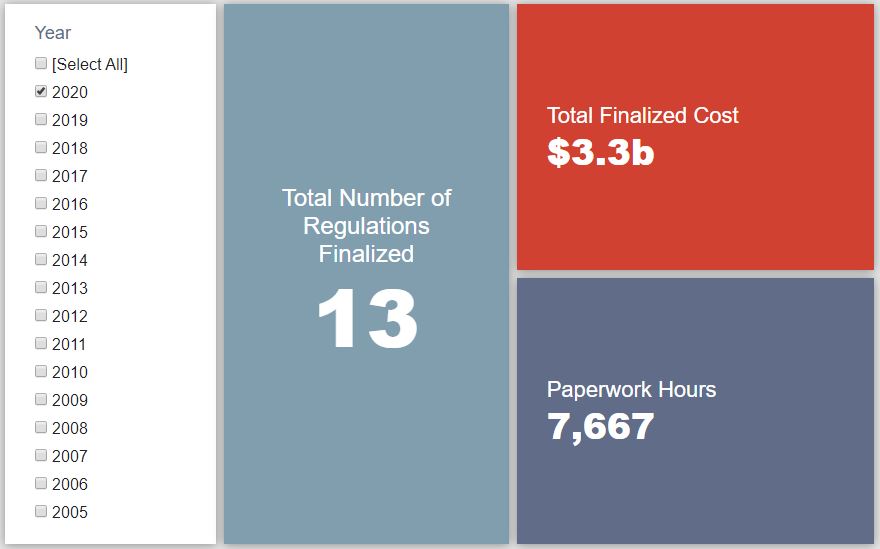Week in Regulation
January 21, 2020
A Wintry Mix
Last week, there were a dozen rulemakings that hit the pages of the Federal Register that included quantifiable economic estimates. There was, however, little in the way of broader trends to glean from these regulations. Perhaps it is fitting then that the most notable action of the week – the Department of Labor’s (DOL) revised “Joint Employer” rule – stands as yet another intriguing case study in the complications of regulatory budgeting. Across all rulemakings, agencies published $352.1 million in total net costs but cut 357,485 hours of annual paperwork.
REGULATORY TOPLINES
- 2020 Proposed Rules: 42
- 2020 Final Rules: 66
- 2020 Total Pages: 3,219
- 2020 Final Rule Costs: $3.3 billion
- 2020 Proposed Rule Costs: $689.5 million
TRACKING THE REGULATORY BUDGET
DOL finalized its rule that updates the “Joint Employer Status Under the Fair Labor Standards Act” last Thursday. The move marked a long-awaited deregulatory action from the administration and is recorded as such for the purposes of the fiscal year (FY) 2020 regulatory budget under Executive Order (EO) 13,771. Much like its proposed version, however, the quantifiable effects come out to net costs. This is primarily due to regulatory familiarization, essentially the opportunity cost of employees spending time reviewing the new regulatory requirements instead of their usual tasks. DOL estimates that these costs could reach $27.3 million annually, or $390 million in net present value. The agency contends though that the rule will have net cost savings due to a greater clarity on the part of employers and subsequently less litigation surrounding their status. Despite soliciting such input in the proposed rule, “The Department did not receive any comments providing data needed to quantify these impacts.”
Since there were no other actions applicable to EO 13,771, the FY 2020 tally remains stagnant for the week. The Trump Administration expects to reach $51.6 billion in cumulative net savings in FY 2020. To date in the fiscal year, agencies have finalized 40 deregulatory actions and 13 regulatory actions, totaling $3 billion in quantified total net costs.
THIS WEEK’S REGULATORY PICTURE
This week, one of the most anticipated rules of the Trump Administration heads to the White House.

The Office of Information and Regulatory Affairs (OIRA) began its review of the Safer Affordable Fuel-Efficient (SAFE) Vehicles Rule on January 14. The rule is widely expected to be the largest single deregulatory rule by net savings of the Trump Administration. When proposed in August 2018, it was estimated to save about $370 billion (at the 7 percent discount rate preferred under regulatory budget accounting). Its savings was expected to be so large that OIRA said it would not include it in its regulatory budget accounting because it would skew the results. That thinking has now changed, and an early projection of the final rule’s savings appears to be about $80 billion.
Under Executive Order 12,866, signed by President Clinton in 1993, significant rules are reviewed by OIRA to ensure they are consistent with administration policy and that all legally required analyses — like a consideration of costs and benefits — have been adequately completed. Review typically lasts anywhere from 30-90 days for the largest and most controversial rules.
During this review period, OIRA also coordinates inter-agency review whereby other federal agencies can weigh in on the rule and its possible unforeseen effects on other agencies. In addition, OIRA allows for members of the public to request a meeting. OIRA will then hold a meeting with representatives from the agency or agencies developing the rule and the requesting members of the public. At these meetings, the requesting party can share views and information that might be helpful for OIRA to consider as it reviews the rule in question. OIRA staff will not offer information on the contents of the rule and typically will only ask clarifying questions. A disclosure of the meeting is posted online to ensure transparency.
During development of the proposed and final SAFE rule, there have been 41 meetings held as of this writing. Many more should be expected now that the rule is in the final stage of its development. The number of meetings requested will likely factor into the duration of the rule’s review by OIRA, but the rule appears headed for a springtime release.
TOTAL BURDENS
Since January 1, the federal government has published $4 billion in total net costs (with $3.3 billion in finalized costs) and 11.5 million hours of net annual paperwork burden increases (with 7,667 hours cut by final rules). Click here for the latest Reg Rodeo findings.












